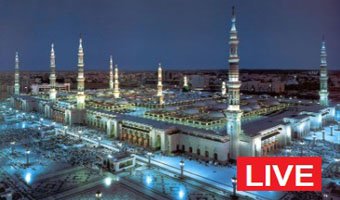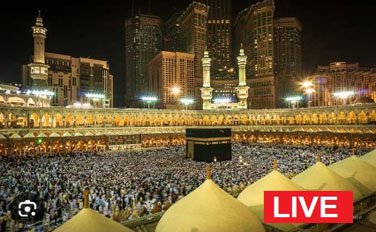Exploring Egypt's Mosques: Spiritual Marvels and Historical Treasures
Explore the spiritual wonders and historical marvels of Egypt, including its majestic mosques and significant landmarks. Dive into a journey of cultural richness and spiritual enlightenment.
History
Egypt’s story stretches back thousands of years, unfolding like a old saga. Here’s a condensed version.
Act 1: The Rise of Pharaohs (3150 – 1070 BC)
- Unified around 3150 BC, kickstarting a powerful civilization.
- Pharaohs rule as god-kings, building iconic pyramids and temples.
- The Old Kingdom (2700-2200 BC) sees the rise of pyramids like Giza.
- The Middle Kingdom (2052-1650 BC) brings stability and cultural flourishing.
- The New Kingdom (1550-1070 BC) is Egypt’s golden age, with vast empires.
Act 2: Shifting Sands (1070 BC – 30 BC)
- Egypt faces foreign invasions and internal struggles.
- The Nubians, Assyrians, Persians, and Greeks conquer or rule Egypt at times.
- Despite challenges, Egyptian culture persists.
- Alexander the Great conquers Egypt in 332 BC, ushering in the Hellenistic era.
Act 3: New Rulers (30 BC – Present Day)
- Romans take control of Egypt in 30 BC, making it a province.
- Christianity spreads in Egypt.
- Arabs conquer Egypt in 641 AD, Islam becomes dominant.
- Egypt goes through periods of Ottoman and European rule.
- In 1922, Egypt becomes a kingdom, gaining full independence in 1954.
This is just a glimpse! Egypt’s story is filled with fascinating details, pharaohs, inventions, and cultural wonders.
How Many Mosques Are There in Egypt?
There are estimates that suggest around 110,000 mosques located throughout Egypt. This information is based on reports by German media outlet Qantara.
Al-Azhar Mosque: Unveiling the Jewel of Cairo (969 CE - Present)

Towering over the historic streets of Cairo, the Al-Azhar Mosque stands as a magnificent testament to Islamic faith, education, and cultural exchange. Founded in 969 CE, it’s not just a place of worship; it’s a beacon of knowledge that has illuminated minds for over a millennium. Embark on a captivating exploration of Al-Azhar Mosque, delving into its rich history, architectural marvels, and enduring legacy.
A Flourishing Center of Knowledge (969 CE):
The Fatimid Caliph Al-Mu’izz li-Din Allah commissioned the construction of Al-Azhar Mosque in 969 CE. It was envisioned not only as a grand mosque but also as a center of learning. Scholars of various disciplines were invited to teach, fostering a vibrant intellectual atmosphere. Over the centuries, Al-Azhar evolved into a prestigious university, attracting students from across the Muslim world.
A Historical Conversation: The Mosque’s Evolving Role (Uncertain Date):
A captivating anecdote highlights the evolving role of Al-Azhar Mosque. It is narrated that during a time of political turmoil, the mosque’s doors were closed. A scholar is said to have remarked, “If the call to prayer is not heard from Al-Azhar, then the hearts of the believers will become weary.” This conversation underscores the mosque’s significance as a symbol of stability and a cornerstone of the Muslim community in Cairo.
Architectural Grandeur: A Blend of Styles (969 CE – Ongoing)
Al-Azhar Mosque’s architectural style reflects its rich history. Fatimid influences are evident in the spacious courtyards and fluted minarets. Over the centuries, additions and renovations in Mamluk and Ottoman styles have further enriched the mosque’s architectural tapestry. The ornately decorated prayer halls, intricate calligraphy, and exquisite mosaics leave visitors in awe.
A Place of Worship and Spiritual Connection:
At the heart of Al-Azhar Mosque lies its role as a sacred space for worship and prayer. The melodious call to prayer echoes through the courtyards, inviting the faithful to connect with the Divine. The serene atmosphere fosters contemplation and spiritual reflection for Muslims worldwide.
Duas for Knowledge and Guidance:
While there aren’t specific supplications unique to Al-Azhar Mosque, visitors can incorporate the spirit of the mosque’s scholarly heritage into their prayers. Here are some examples:
- For seeking knowledge: “Allah (SWT), grant me the ability to learn and understand, like the scholars who graced the halls of Al-Azhar Mosque.”
- For guidance on the right path: “Allah (SWT), guide me towards knowledge and wisdom, as You have guided countless seekers at Al-Azhar Mosque throughout history.”
- For the preservation of Islamic knowledge: “Allah (SWT), preserve the legacy of Al-Azhar Mosque as a beacon of Islamic knowledge for generations to come.”
Conclusion: A Legacy That Endures
Al-Azhar Mosque transcends its architectural beauty. It stands as a symbol of:
- The Importance of Education: Al-Azhar’s dedication to learning serves as a beacon for the pursuit of knowledge in all its forms.
- Interfaith Dialogue: The mosque has historically fostered dialogue and understanding between different schools of Islamic thought.
- A Living Legacy: Al-Azhar Mosque continues to evolve, adapting to the needs of the times while preserving its rich heritage.
As the call to prayer resonates through the bustling streets of Cairo, Al-Azhar Mosque remains a vibrant center of faith, scholarship, and cultural exchange, inspiring hearts and minds for centuries to come.
Muhammad Ali Mosque: An Alabaster Jewel Unveiling its Story (1830-1848)
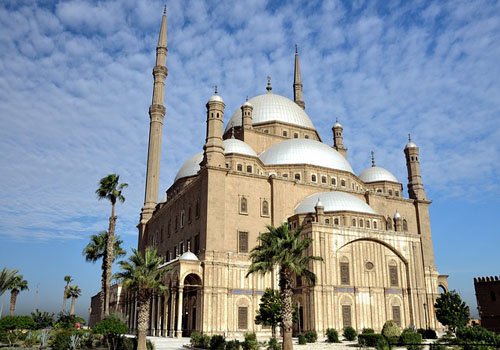
Soaring majestically above the rooftops of Cairo, the Muhammad Ali Mosque stands as a captivating landmark. This architectural marvel, constructed between 1830 and 1848, embodies Ottoman grandeur and offers a glimpse into the vision of a remarkable ruler. Embark on a journey to explore the history, architectural splendor, and enduring legacy of the Muhammad Ali Mosque.
A Monument to Ambition (1830):
Muhammad Ali, the ambitious ruler of Egypt during the first half of the 19th century, commissioned the construction of the mosque. He envisioned a monument that would not only be a grand house of worship but also a symbol of his power and Egypt’s modernization efforts.
A Conversation Highlighting Inspiration (1830s):
Inspired by Ottoman mosques, particularly the Hagia Sophia in Istanbul, Muhammad Ali envisioned a monumental structure. It is said that he instructed the architect to “build me a mosque that will be seen from all parts of Cairo.” This anecdote highlights his desire to create a landmark that would leave a lasting impression.
Ottoman Influences with Local Flair (1830-1848):
The Muhammad Ali Mosque showcases a blend of Ottoman architectural styles and local Egyptian influences. The towering dome, slender minarets, and spacious courtyards echo Ottoman mosque design. However, the mosque’s exterior is clad in alabaster, a material traditionally used in Pharaonic monuments, adding a unique Egyptian touch.
A Journey Through Grandeur:
Visitors to the Muhammad Ali Mosque are greeted by a sense of awe. The alabaster facade shimmers in the sunlight, while the intricate details on the doorways and windows captivate the eye. The expansive interior features a central prayer hall adorned with chandeliers and colorful carpets. The walls boast calligraphy and geometric patterns, creating a mesmerizing ambiance.
A Place of Worship and Reflection:
Despite its grandeur, the Muhammad Ali Mosque serves as a functioning house of worship. The melodious call to prayer echoes through the halls, inviting the faithful for daily prayers. The serene atmosphere fosters a sense of peace and allows for quiet contemplation.
Duas for Peace and Prosperity:
While specific supplications aren’t tied exclusively to the Muhammad Ali Mosque, visitors can find inspiration in its history and location. Here are some examples:
- For peace in the region: “Allah (SWT), grant peace and harmony to the land of Egypt and its people.”
- For the well-being of the nation: “Allah (SWT), bless Egypt with prosperity and guide its leaders towards justice and wisdom.”
- For unity within the Muslim community: “Allah (SWT), unite the hearts of Muslims around the world, as they stand together in prayer at mosques like this one.”
A Legacy of Power and Beauty:
The Muhammad Ali Mosque stands as a testament to:
- A Ruler’s Ambition: The mosque reflects Muhammad Ali’s desire to modernize Egypt and leave a lasting legacy.
- Ottoman Architectural Influence: It showcases the grandeur and artistry of Ottoman mosque design.
- A Blend of Cultures: The mosque’s architecture reflects the confluence of Ottoman and Egyptian styles.
Today, the Muhammad Ali Mosque continues to be a captivating landmark, drawing visitors from all walks of life. It serves as a powerful reminder of the artistry, ambition, and faith that shaped its creation.
Sultan Hassan Mosque: A Majestic Tapestry Unveiling its Story (1356-1363)

Amidst the vibrant tapestry of Cairo’s Islamic district lies the Sultan Hassan Mosque, a masterpiece of Mamluk architecture. This awe-inspiring structure, built between 1356 and 1363, reflects the artistic brilliance and devotion of a bygone era. Embark on a captivating exploration of the Sultan Hassan Mosque, delving into its rich history, architectural wonders, and enduring legacy.
A Legacy Etched in Stone (1356):
Sultan Hassan, the Mamluk ruler who commissioned the mosque, envisioned it as a grand monument to house his tomb. He desired a structure that would not only be a place of worship but also a testament to his reign. The construction process was meticulous and involved skilled artisans who employed a variety of techniques to create a masterpiece.
A Royal Conversation: The Mosque’s Purpose (1356):
Historical accounts mention a conversation between Sultan Hassan and the mosque’s architect. The Sultan is said to have declared, “Build me a mosque that has never been seen before and will never be seen again.” This exchange highlights Sultan Hassan’s desire for an unprecedented and awe-inspiring structure.
A Fusion of Mamluk Brilliance (1356-1363):
The Sultan Hassan Mosque embodies the peak of Mamluk architectural achievements. The towering facade features intricate stonework with geometric patterns and Qur’anic calligraphy. The majestic dome, adorned with vibrant mosaics, dominates the skyline. The interior boasts a mesmerizing display of iwans (vaulted halls), arcades, and mihrabs (prayer niches), each adorned with exquisite details.
A Haven for Spiritual Connection:
Despite its royal origins, the Sultan Hassan Mosque serves as a functioning house of worship. The melodic call to prayer echoes through the halls, inviting the faithful for daily prayers. The serene atmosphere fosters a sense of peace and allows for quiet contemplation.
Duas for Gratitude and Reflection:
While there aren’t specific supplications unique to the Sultan Hassan Mosque, the mosque’s grandeur inspires reflection and gratitude. Here are some examples:
- For appreciation of beauty: “Allah (SWT), I thank You for the gift of artistic expression, evident in the beauty of this mosque.”
- For guidance on the path of faith: “Allah (SWT), grant me the ability to focus on my prayers and deepen my connection with You, as I stand in this magnificent house of worship.”
- For the preservation of Islamic heritage: “Allah (SWT), preserve the Sultan Hassan Mosque and other architectural marvels for generations to come, as a testament to our rich history.”
Conclusion: A Timeless Legacy
The Sultan Hassan Mosque stands as a symbol of:
- Mamluk Artistic Brilliance: The mosque’s intricate details and architectural ingenuity showcase the peak of Mamluk artistic achievements.
- A Royal Vision Realized: Sultan Hassan’s desire for a unique and awe-inspiring structure is manifested in the mosque’s grandeur.
- A Place of Worship for All: Despite its royal origins, the mosque serves as a welcoming space for prayer and reflection for all Muslims.
The Sultan Hassan Mosque continues to captivate visitors with its timeless beauty and rich history. It serves as a permanent reminder of the artistry, devotion, and architectural brilliance of the Mamluk era.
Al-Hakim bi-Amr Allah Mosque (990-1013 CE) Unveiling the Enigmatic
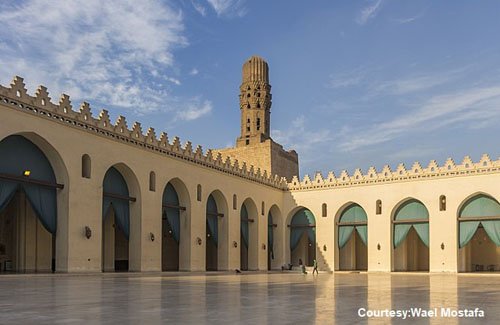
Standing amidst the bustling streets of Cairo, the Al-Hakim bi-Amr Allah Mosque holds a unique place in Islamic history. Constructed between 990 and 1013 CE by the Fatimid Caliph Al-Hakim bi-Amr Allah, this enigmatic structure is more than just a place of worship; it’s a captivating tapestry woven with history, architectural marvels, and a touch of mystery. Embark on a captivating journey to explore the Al-Hakim bi-Amr Allah Mosque.
A Legacy of the Fatimid Era (990 CE):
Caliph Al-Hakim envisioned the mosque as a grand expression of Fatimid faith and power. The Fatimids were a Shia dynasty that ruled Egypt during the 10th-12th centuries CE. The mosque’s design incorporated innovative architectural elements, reflecting the Fatimid artistic vision.
A Conversation Shrouded in Mystery (Uncertain Date):
The reign of Caliph Al-Hakim remains shrouded in some mystery. Legends mention him disappearing from public life after a particular incident. Some historical accounts suggest a conversation where he expressed his desire for the mosque to be hidden from public view until the Day of Judgement. While the veracity of this conversation is debatable, it adds to the mosque’s aura of intrigue.
Architectural Innovation and Fatimid Grandeur (990-1013 CE):
The Al-Hakim bi-Amr Allah Mosque showcases a unique architectural style. The prayer hall features an unusual T-shaped layout, a departure from the traditional rectangular design of many mosques. The mosque also boasts a distinctive ablution fountain and a rare remaining minaret from the Fatimid period. While some renovations were made in later eras, the core structure retains its Fatimid essence.
A Place of Worship and Tranquility:
Despite its historical significance, the Al-Hakim bi-Amr Allah Mosque continues to function as a house of worship. The melodic call to prayer echoes through the halls, inviting the faithful for daily prayers. The serene atmosphere provides a haven for quiet contemplation and spiritual connection.
Duas for Guidance and Understanding:
While there aren’t specific supplications unique to the Al-Hakim bi-Amr Allah Mosque, the mosque’s history inspires reflection. Here are some examples:
- For guidance in times of uncertainty: “Allah (SWT), grant me wisdom and clarity, as I stand in this mosque that has witnessed centuries of change.”
- For understanding the diversity of Islamic traditions: “Allah (SWT), help me appreciate the rich tapestry of Islamic history and architecture, reflected in this unique mosque.”
- For the preservation of historical landmarks: “Allah (SWT), preserve the Al-Hakim bi-Amr Allah Mosque and other historical sites, so they continue to educate and inspire future generations.”
Conclusion: A Legacy That Endures
The Al-Hakim bi-Amr Allah Mosque stands as a testament to:
- Fatimid Architectural Innovation: The mosque’s unique design elements showcase the artistic brilliance of the Fatimid era.
- A Window into Islamic History: It serves as a tangible link to a pivotal period in Islamic history.
- A Place of Faith for All: Despite its historical significance, the mosque remains a welcoming space for prayer and reflection for Muslims worldwide.
The Al-Hakim bi-Amr Allah Mosque, with its intriguing past and captivating architecture, continues to intrigue visitors and serves as a reminder of the rich tapestry of Islamic history.
Abu al-Abbas al-Mursi Mosque: A Beacon of History, Spirituality, and Miracles

The Abu al-Abbas al-Mursi Mosque, a radiant jewel in the crown of Alexandria, Egypt, transcends the realm of mere architecture. It’s a place woven with rich history, inspiring miracles, and the profound spiritual legacy of Sufi mystic Abu al-Abbas al-Mursi.
A Journey Through Time (with Years):
- 1286: The story begins with the passing of Abu al-Abbas al-Mursi. He’s laid to rest in a small cemetery within Alexandria.
- Early 14th Century: A modest qubba, a cubed structure, is erected over his tomb, marking a place of reverence.
- 1307: Witnessing the growing devotion, a mosque is built around the shrine by Zain al-Din al-Qattan, a merchant and Sufi leader.
- 1477: The Mamluk emir of Alexandria recognizes the mosque’s significance and orders a grander structure to be built.
- 1934: King Fouad I takes a pivotal step. He commissions the creation of a mosque square, encompassing the shrines of Al-Busiri and Yaqut al-Arshy, with Abu al-Abbas al-Mursi Mosque standing proudly at its center.
Conversations in Stone and Spirit:
Imagine the dialogues that echoed within these walls. Sufi scholars like al-Mursi himself, renowned for their piety and wisdom, would have engaged in profound discussions on faith, philosophy, and the divine. Worshippers from all walks of life would have offered their prayers, seeking solace and guidance. The whispers of pilgrims recounting miracles attributed to al-Mursi’s intercession would have filled the air, solidifying the mosque’s spiritual significance.
Miracles: Beacons of Faith
Legends abound around the Abu al-Abbas al-Mursi Mosque. One famous story tells of a ship caught in a ferocious storm. The crew, fearing for their lives, called upon al-Mursi for help. Miraculously, the storm calmed, and the ship reached safety. These tales, while possibly embellished over time, speak to the enduring faith and reverence felt by devotees.
Duas for Every Heart
Within the mosque’s embrace, visitors can find solace in offering their own prayers (duas). Here are some examples:
- For Guidance: “Allahumma inni as-alוקה al-huda wal-ʿafia” (O Allah, I ask You for guidance and well-being)
- For Peace: “Allahumma aʿinni ʿala dhikrika wa shukrika wa husn al-ʿibadatika” (O Allah, help me in remembering You, thanking You, and worshipping You well)
- For Needs: “Rabbi ishrah li صدري [sadri] wa yassir li أمري [amri] wa हल عقدة من لساني [lisani] يفقهوا قولي [qawli]” (My Lord, expand for me my chest [make things easy for me] and facilitate for me my task and untie the knot from my tongue so that they may understand my speech)
A Legacy That Endures
Today, the Abu al-Abbas al-Mursi Mosque remains a vibrant center of worship and pilgrimage. It serves as a testament to the enduring legacy of Sufi mysticism and the profound impact of Abu al-Abbas al-Mursi’s life and teachings.
More to Explore:
- The mosque’s architecture is a captivating blend of Ottoman and Mamluk styles. The towering minaret, intricate calligraphy, and mesmerizing domes leave a lasting impression.
- While respectful attire is always recommended when visiting mosques, women may also want to bring a headscarf to cover their hair.
- Photography is usually permitted within the mosque grounds, but it’s always best to ask for permission before taking pictures of worshippers.
The Abu al-Abbas al-Mursi Mosque is more than just a place of worship; it’s a captivating tapestry woven with history, spirituality, and wonder. It beckons you to explore its depths, experience its serenity, and perhaps even witness a miracle of your own.
The Ibn Tulun Mosque: Unveiling its Grandeur and Enduring Legacy

Standing tall amidst the bustling streets of Cairo, Egypt, the Ibn Tulun Mosque isn’t just a place of worship, it’s a portal to a bygone era. Steeped in history, whispered conversations, and architectural brilliance, this mosque is a must-visit for anyone seeking a profound cultural experience.
A Timeline Carved in Stone (with Years):
- 870 AD: Ibn Tulun, the powerful governor of Abbasid Egypt, embarks on an ambitious project. He lays the foundation stone for a grand mosque, aiming to rival the grandeur of Baghdad’s mosques.
- 879 AD: After nine years of meticulous construction, the Ibn Tulun Mosque opens its doors to worshippers.
- Centuries Following: The mosque undergoes renovations and additions by various rulers, each adding their own unique touch.
- Today: The Ibn Tulun Mosque continues to be a revered landmark, a testament to the architectural prowess of a bygone era, and a vibrant center of Islamic faith.
Conversations Through the Ages
Imagine the dialogues that have transpired within these ancient walls. Scholars would have engaged in theological debates, students learned the intricacies of the Quran, and worshippers from all walks of life would have offered their prayers, their voices echoing through the serene courtyard. These conversations, both spoken and unspoken, have woven the very soul of the mosque.
Miracles Attributed to Divine Intervention
The Ibn Tulun Mosque is not without its share of legendary miracles. One popular story recounts a devastating fire that threatened to engulf the mosque. As the flames raged, a torrential downpour miraculously extinguished the blaze, saving the sacred structure. Whether fact or embellished with time, such tales speak to the enduring faith held by devotees.
Duas for Every Soul
Within the tranquil embrace of the mosque, visitors can find solace by offering their own prayers (duas). Here are some examples:
- For Peace: “Allahuma aatina fid-dunya hasanatan wa fil-akhirah hasanatan wa qinaa `adhaban-naar” (O Allah, grant us goodness in this world and goodness in the Hereafter, and save us from the punishment of the Hellfire)
- For Guidance: “Rabbi arinii al-rushada wa-jurniha” (My Lord, show me the right course and make me firm upon it)
- For Strength: “Allahumma laa kaha illa bika” (O Allah, there is no power except with You)
A Legacy Etched in Brick and Mortar
The Ibn Tulun Mosque stands as a powerful symbol of Islamic architectural mastery. Influenced by ancient Egyptian and Mesopotamian styles, the mosque features a unique spiral minaret, a spacious central courtyard, and captivating stucco and wood decorations.
More to Explore:
- When visiting the mosque, dress modestly with shoulders and knees covered.
- Photography is usually permitted, but it’s always a good idea to be respectful and avoid taking pictures of worshippers engaged in prayer.
- Explore the surrounding area and delve deeper into the rich historical tapestry of Cairo.
The Ibn Tulun Mosque: A Beacon of Faith and History
The Ibn Tulun Mosque is more than a structure; it’s a living testament to a glorious past. Its enduring legacy continues to inspire and captivate visitors from all corners of the globe. Whether seeking spiritual solace, architectural wonder, or a glimpse into Islamic history, the Ibn Tulun Mosque offers an unforgettable experience.
Mosque-Madrasa of Sultan Barquq - A Legacy of Faith and Education.Unveiling

Nestled within the vibrant chaos of Islamic Cairo, Egypt, lies the Mosque-Madrasa of Sultan Barquq, a captivating complex whispering tales of a bygone era. It’s not just a mosque, but a unique blend of religious and educational spaces, offering a glimpse into the Mamluk Sultanate’s architectural prowess and commitment to learning.
A Journey Through Time (with Years):
- 1386 AD: Following his ascension to the throne, Sultan Barquq embarks on an ambitious project – the construction of a grand mosque-madrasa complex.
- 1390 AD: After four years of meticulous work, the complex opens its doors, welcoming worshippers and scholars alike.
- Centuries Following: The complex undergoes renovations and additions by various rulers, ensuring its continued use as a center of learning and faith.
- Today: The Mosque-Madrasa of Sultan Barquq stands as a magnificent testament to Mamluk architecture, serving as a place of worship and a reminder of the era’s dedication to education.
Conversations That Transcended Time
Imagine the dialogues that resonated within these very walls. Within the mosque, worshippers would have offered their prayers, their voices weaving together in a tapestry of devotion. In the madrasa (Islamic school), scholars would have engaged in lively debates on theology, law, and science, their voices echoing through the courtyards, fostering knowledge and intellectual pursuit.
Miracles Woven into Legend
The Mosque-Madrasa of Sultan Barquq is not without its share of legendary miracles. One popular story tells of a time when the Nile River overflowed, threatening to engulf the complex. Miraculously, the waters receded just before reaching the walls, saving the structure from destruction. While such tales may be embellished, they speak to the enduring faith held by the mosque’s devotees.
Duas for the Soul’s Journey
Within the serene atmosphere of the mosque, visitors can find solace by offering their own prayers (duas). Here are some examples:
- For Knowledge: “Allahumma ya muʿallim al-mutaʿallimin, ʿallimanī” (O Allah, You are the Teacher of those who learn, teach me)
- For Guidance: “Rabbi ishrah li صدري [sadri] wa yassir li أمري [amri] wa حل عقدة من لساني [lisani] يفقهوا قولي [qawli]” (My Lord, expand for me my chest [make things easy for me] and facilitate for me my task and untie the knot from my tongue so that they may understand my speech)
- For Success in This World and the Hereafter: “Rabbi ajʿalni muqīma al-ṣalāh wa min dhurriyyatī, rabbanā wa taqabbal duʿāʾ, innaka anta al-samīʿu al-ʿalīm” (My Lord, make me an establisher of prayer, and from my descendants. Our Lord, and accept the supplication. Indeed, You are the Hearing, the Knowing)
A Legacy in Stone and Knowledge
The Mosque-Madrasa of Sultan Barquq is an architectural marvel. The complex boasts towering minarets, an ornate prayer hall, serene courtyards, and dedicated quarters for students and scholars. The Mamluk-style architecture, with its intricate stonework and calligraphy, is a captivating sight to behold.
More to Explore:
- When visiting the mosque, dress modestly with shoulders and knees covered.
- Photography is usually permitted, but it’s always a good idea to be respectful and avoid taking pictures of worshippers engaged in prayer.
- Explore the vibrant surrounding district of Islamic Cairo and delve deeper into the rich tapestry of Mamluk history.
A Beacon of Faith and Learning: The Enduring Legacy
The Mosque-Madrasa of Sultan Barquq transcends its role as a place of worship. It’s a symbol of the Mamluk era’s dedication to religious devotion and the pursuit of knowledge. Standing tall amidst the bustling city, it beckons visitors to explore its architectural grandeur, experience its serenity, & perhaps even whisper their own prayers within its hallowed halls.
Amr Ibn Al-As: A Complex Legacy of Faith, Conquest, and Mosque-Building

Amr ibn al-As, a name that resonates through Islamic history, was a man of multifaceted legacy. He was a companion of the Prophet Muhammad, a skilled military leader, and the founder of the first mosque in Africa – the Amr ibn al-As Mosque in Fustat, Egypt.
A Journey Through Time (with Years):
- Early Life: Born into a prominent clan of Mecca, Amr initially opposed Islam.
- 612 AD: He converted to Islam after witnessing the truth of the Quran.
- 622 AD: Amr migrated with the Prophet Muhammad to Medina.
- 624 AD: He participated in the Battle of بدر (Badr), the first major battle between Muslims and Meccans.
- 630 AD: Amr played a role in the destruction of idols worshipped by Arab tribes.
- 638-642 AD: He emerged as a prominent military leader during the Muslim conquest of Egypt.
- 641-642 AD: Amr oversaw the construction of the first mosque in Africa – the Amr ibn al-As Mosque – in the newly founded Egyptian capital, Fustat.
- 662 AD: Amr passed away in Egypt.
Conversations Echoing Through Time
Imagine the dialogues Amr ibn al-As would have been part of. Early discussions with the Prophet Muhammad about the fledgling Islamic faith, strategic war councils with fellow commanders during the conquest of Egypt, and perhaps even conversations with local Egyptians as they embraced Islam. These conversations, both documented and imagined, paint a picture of a complex and influential figure.
Miracles and Controversies
While some accounts credit Amr with miraculous feats during the conquest of Egypt, these are debated by historians. His legacy is more grounded in his military leadership and the establishment of the first mosque in Africa, a pivotal moment in the spread of Islam.
Duas for Guidance and Strength
As a companion of the Prophet, Amr ibn al-As would have been well-versed in Islamic prayers (duas). Here are some examples:
- For Guidance: “Allahumma a’inni ala dhikrika wa shukrika wa husn al-‘ibadatika” (O Allah, help me in remembering You, thanking You, and worshipping You well)
- For Strength in Facing Challenges: “Hasbunallah wa ni’mal wakil” (Allah is sufficient for us, and He is the best Disposer of affairs)
- For Success in This World and the Hereafter: “Rabbi ajʿalni muqīma al-ṣalāh wa min dhurriyyatī, rabbanā wa taqabbal duʿāʾ, innaka anta al-samīʿu al-ʿalīm” (My Lord, make me an establisher of prayer, and from my descendants. Our Lord, and accept the supplication. Indeed, You are the Hearing, the Knowing)
A Legacy in Mosque and Military Strategy
Amr’s most enduring legacy lies in the Amr ibn al-As Mosque. It stands as a testament to the early spread of Islam and the importance of establishing places of worship for the growing Muslim community in Egypt. His military strategies, while controversial in some aspects, were instrumental in the Muslim conquest of Egypt.
Conclusion: A Man and His Mosque
Amr ibn al-As’s legacy is a tapestry woven with threads of faith, military conquest, and mosque-building. While his role in Islamic history is debated, there’s no denying the significance of the Amr ibn al-As Mosque as a symbol of Islam’s early expansion into Africa. His story offers a window into a pivotal period of Islamic history, inviting contemplation and further exploration.
Juyushi Mosque: A Haven of History, Miracles, and Serenity
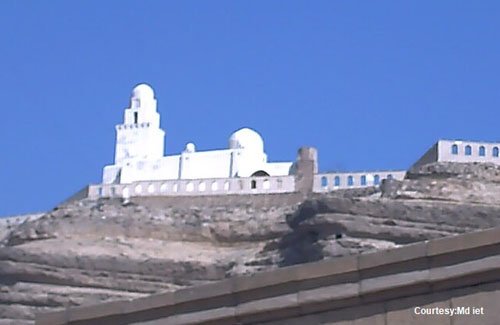
Nestled within the vibrant tapestry of Cairo, Egypt, lies the Juyushi Mosque, a historical gem whispering tales of the Fatimid era. More than just a place of worship, it’s a captivating monument imbued with rich history, inspiring miracles, and the spiritual legacy of Imam al-Mustansir Billah.
A Journey Through Time (with Years):
- 1085 AD: Following the reign of the Fatimid Imam-Caliph al-Mustansir Billah, construction of the Juyushi Mosque (meaning “Mosque of the Armies”) commences.
- Comissioned by Badr al-Jamali: This powerful Fatimid vizier (high official) recognizes the need for a grand mosque to serve the growing military presence in the area.
- Centuries Following: The Juyushi Mosque undergoes renovations and additions by various rulers, ensuring its continued use as a place of worship.
- Today: The Juyushi Mosque stands proudly as a testament to Fatimid architecture and a vibrant center of Islamic faith.
Conversations Through the Ages
Imagine the dialogues that resonated within these very walls. Fatimid scholars would have engaged in theological debates, soldiers preparing for battle would have sought solace in prayer, and worshippers from all walks of life would have offered their supplications, their voices echoing through the serene courtyards. These conversations, both spoken and unspoken, weave the very soul of the mosque.
Miracles Woven into Legend
The Juyushi Mosque is not without its share of legendary miracles. One popular story recounts a time of immense drought. With prayers offered within the mosque, rain miraculously poured forth, alleviating the hardship and solidifying the mosque’s significance as a place of divine intervention. Whether fact or embellished with time, such tales speak to the enduring faith held by the mosque’s devotees.
Duas for Every Heart
Within the tranquil embrace of the mosque, visitors can find solace by offering their own prayers (duas). Here are some examples:
- For Peace and Prosperity: “Allahumma antas-salaamu wa minkas-salaamu, tabaarakta ya dhal jalaali wal-ikraam” (O Allah, You are peace, and from You is peace, blessed are You, O Owner of majesty and dignity)
- For Guidance: “Rabbi arinii al-rushada wa-jurniha” (My Lord, show me the right course and make me firm upon it)
- For Strength in Facing Challenges: “Hasbunallah wa ni’mal wakil” (Allah is sufficient for us, and He is the best Disposer of affairs)
A Legacy Etched in Stone
The Juyushi Mosque stands as a captivating example of Fatimid architecture. The mosque boasts a spacious central courtyard, an ornate prayer hall adorned with intricate stuccowork, and a towering minaret. These architectural elements transport visitors back to a bygone era of artistic brilliance.
More to Explore:
- When visiting the mosque, dress modestly with shoulders and knees covered.
- Photography is usually permitted, but it’s always a good idea to be respectful and avoid taking pictures of worshippers engaged in prayer.
- Explore the surrounding Islamic Cairo district and delve deeper into the rich history of the Fatimid Caliphate.
A Haven of Serenity: The Enduring Legacy
The Juyushi Mosque transcends its role as a place of worship. It’s a captivating monument whispering tales of a bygone era, a testament to Fatimid architectural mastery, and a haven of serenity for worshippers and visitors alike. Whether seeking spiritual solace, historical intrigue, or architectural beauty, the Juyushi Mosque offers an unforgettable experience.
Al-Rifa'i Mosque - A Beacon of History, Beauty, and Serenity
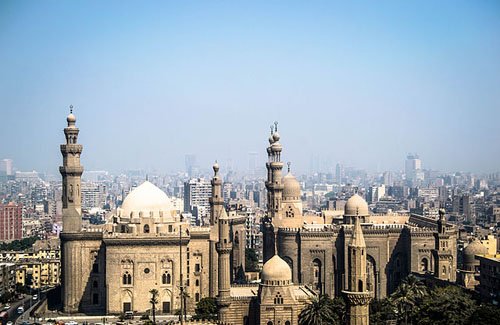
tanding tall amidst the bustling streets of Cairo, Egypt, the Al-Rifa’i Mosque isn’t just a place of worship, it’s a captivating architectural masterpiece. Steeped in history, whispered conversations, and adorned with exquisite details, this mosque is a must-visit for anyone seeking a profound cultural experience.
A Journey Through Time (with Years):
- 1869 AD: Following the death of Sufi saint Sayyid Ahmad al-Rifa’i, Khedive Ismail Pasha commissions the construction of a grand mosque as his mausoleum.
- 1906 AD: After nearly four decades of meticulous work, the Al-Rifa’i Mosque opens its doors to worshippers and visitors alike.
- A Blend of Styles: The mosque’s architecture incorporates Ottoman, Mamluk, and European influences, creating a unique and captivating blend.
- Today: The Al-Rifa’i Mosque continues to be a revered landmark, a testament to the city’s rich history and a vibrant center of Islamic faith.
Conversations Through the Ages
Imagine the dialogues that resonated within these very walls. Worshippers from all walks of life would have offered their prayers, their voices weaving together in a tapestry of devotion. Scholars might have engaged in theological debates, and pilgrims would have recounted stories of the revered Sayyid Ahmad al-Rifa’i. These conversations, both spoken and unspoken, breathe life into the soul of the mosque.
Miracles Attributed to Divine Intervention
The Al-Rifa’i Mosque is not without its share of legendary miracles. One popular story tells of a young boy who fell from the mosque’s minaret but was miraculously saved by the intervention of Sayyid Ahmad al-Rifa’i. Whether fact or embellished with time, such tales speak to the enduring faith held by the mosque’s devotees.
Duas for Every Heart
Within the tranquil embrace of the mosque, visitors can find solace by offering their own prayers (duas). Here are some examples:
- For Peace and Tranquility: “Allahumma antas-salaamu wa minkas-salaamu, tabaarakta ya dhal jalaali wal-ikraam” (O Allah, You are peace, and from You is peace, blessed are You, O Owner of majesty and dignity)
- For Guidance: “Rabbi arinii al-rushada wa-jurniha” (My Lord, show me the right course and make me firm upon it)
- For Gratitude: “Alhamdulillah ala kulli hal” (Praise be to God in all circumstances)
A Legacy Etched in Stone and Beauty
The Al-Rifa’i Mosque is an architectural marvel. The facade boasts intricate stonework, while the interior dazzles with colorful alabaster panels, gleaming marble floors, and ornate chandeliers. The towering minarets pierce the Cairo skyline, and the mausoleum of Sayyid Ahmad al-Rifa’i lies within the mosque complex, further enriching the historical significance of the site.
More to Explore:
- When visiting the mosque, dress modestly with shoulders and knees covered.
- Photography is usually permitted, but it’s always a good idea to be respectful and avoid taking pictures of worshippers engaged in prayer.
- Explore the surrounding Islamic Cairo district and delve deeper into the city’s rich tapestry of cultures and architectural styles.
A Beacon of Serenity: The Enduring Legacy
The Al-Rifa’i Mosque transcends its role as a place of worship. It’s a captivating monument whispering tales of history, a testament to the fusion of architectural influences, and a haven of serenity for worshippers and visitors alike. Whether seeking spiritual solace, architectural beauty, or a glimpse into Islamic history, the Al-Rifa’i Mosque offers an unforgettable experience.
Al-Hussein Mosque: A Legacy of Reverence, History, and Hope
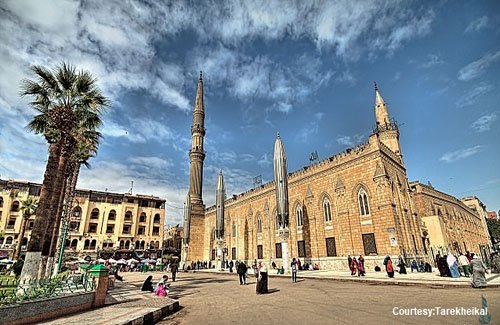
In the vibrant heart of Cairo, Egypt, nestled amidst bustling alleyways, stands the Al-Hussein Mosque. More than just a place of worship, it’s a captivating landmark steeped in history, whispered conversations, and enduring faith. Let’s embark on a journey to explore this mosque’s significance.
A Journey Through Time (with Years):
- 661 AD: Following the historic Islamic Battle of Karbala, the head of Imam Hussein, the grandson of Prophet Muhammad, is believed to be brought to Cairo and enshrined here.
- 1130 AD: The Fatimid Caliph al-Amir orders the construction of a mausoleum over the shrine.
- Centuries Following: The mosque undergoes renovations and additions by various rulers, solidifying its place as a revered pilgrimage site.
- Today: The Al-Hussein Mosque continues to be a focal point for Shia Islamic pilgrimages and a significant mosque for Sunni Muslims as well.
Conversations Through the Ages
Imagine the dialogues that resonated within these very walls. Shia pilgrims would have embarked on emotional journeys to honor Imam Hussein, their voices filled with devotion. Sunni worshippers would have offered their prayers, their presence a testament to the mosque’s significance for the broader Muslim community. Scholars might have engaged in theological discussions, and visitors from all walks of life would have shared stories and found solace within the mosque’s embrace.
Miracles Woven into Legend
The Al-Hussein Mosque is not without its share of legendary miracles. One popular story recounts a time of immense drought. With fervent prayers offered within the mosque, rain miraculously poured forth, alleviating the hardship and solidifying the mosque’s sanctity as a place of divine intervention. Whether fact or embellished with time, such tales speak to the enduring faith held by the mosque’s devotees.
Duas for Every Soul
Within the tranquil embrace of the mosque, visitors can find solace by offering their own prayers (duas). Here are some examples:
- For Healing and Peace: “Allahumma rabbi an nas, adhrib al-basala fi qulubihim wa ashfihim” (O Allah, Lord of mankind, remove distress from their hearts and heal them)
- For Strength and Guidance: “Allahumma inni a’udhu bika min al-kasali wa al-jubuni wa al-bukhli wa min ghalabat ad-dayni wa qahr ar-rijal” (O Allah, I seek refuge in You from laziness, cowardice, miserliness, the overwhelming burden of debt, and the domination of men)
- For Unity in the Muslim Community: “Allahumma allif bina wa baina ikhwana wa aslih ذاتنا [dhatana] wa tawaddanna wa najjina min al-fitnati” (O Allah, bring harmony between us and our brothers, rectify our affairs, make us love one another, and save us from discord)
A Legacy in Stone and Faith
The Al-Hussein Mosque boasts captivating architecture. The ornate facade features towering minarets and intricate calligraphy. The elaborate interior dazzles with colorful mosaics, gleaming marble, and ornate chandeliers. The mausoleum of Imam Hussein lies within the mosque complex, adding to the mosque’s historical and spiritual significance.
More to Explore:
- When visiting the mosque, dress modestly with shoulders and knees covered, especially during important religious commemorations.
- Photography is usually permitted, but be respectful and avoid taking pictures of worshippers engaged in prayer.
- Explore the vibrant surrounding district and immerse yourself in the rich cultural tapestry of Cairo.
A Beacon of Hope: The Enduring Legacy
The Al-Hussein Mosque transcends its role as a place of worship. It’s a symbol of reverence for Imam Hussein, a testament to the enduring spirit of faith, and a beacon of hope for those seeking solace and connection. Whether you’re a pilgrim, a scholar, or a curious visitor, the Al-Hussein Mosque offers an unforgettable experience.
Al-Sayyida Nafisa Mosque: A Beacon of Faith and Devotion
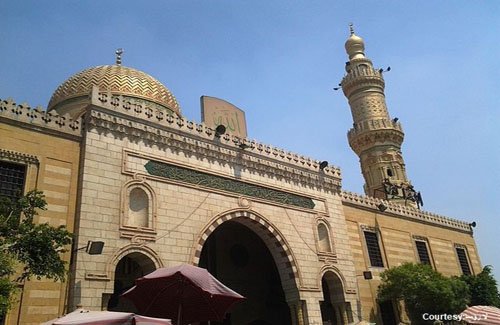
Nestled amidst the vibrant chaos of Cairo, Egypt, the Mosque of Sayyida Nafisa, a captivating monument whispering tales of faith, historical significance, and enduring serenity. More than just a mosque, it’s a place of pilgrimage and a cherished landmark imbued with the legacy of a revered saint.
A Journey Through Time (with Years):
- 824 AD (approximate): Sayyida Nafisa, a great-granddaughter of Prophet Muhammad, arrives in Cairo and takes up residence near the spot where the mosque would be built later.
- 1617 AD: The Ottoman Sultan Murad IV orders the construction of a grand mosque to enshrine the tomb of Sayyida Nafisa.
- Centuries Following: The mosque undergoes renovations and additions by various rulers, ensuring its continued use as a pilgrimage site and a center of worship.
- Today: The Mosque of Sayyida Nafisa remains a significant pilgrimage destination for Muslims, particularly women, and a place of worship for the local community.
Conversations Echoing Through Time
Imagine the dialogues that resonated within these very walls. Pilgrims, particularly women, would have come to pay their respects to Sayyida Nafisa, seeking her blessings and guidance. Worshippers from all walks of life would have offered their prayers, their voices weaving together in a tapestry of devotion. Scholars might have engaged in discussions about Islamic history and the life of Sayyida Nafisa. These conversations, both spoken and unspoken, breathe life into the soul of the mosque.
Miracles Attributed to Divine Intervention
The Mosque of Sayyida Nafisa is not without its share of legendary miracles. One popular story tells of a woman who was unable to conceive. After praying fervently at the mosque, she miraculously became pregnant. Whether fact or embellished with time, such tales speak to the enduring faith held by the mosque’s devotees and the hope it offers to those seeking blessings.
Duas for Every Heart
Within the tranquil embrace of the mosque, visitors can find solace by offering their own prayers (duas). Here are some examples:
- For Wellbeing and Peace: “Allahumma inni أسألك [as-aloka] العافية في الدنيا والآخرة [al-dunya wal-akhira]” (O Allah, I ask You for well-being in this world and the Hereafter)
- For Guidance and Strength: “Rabbi arinii al-rushada wa-jurniha” (My Lord, show me the right course and make me firm upon it)
- For Women Seeking Blessings: “Allahumma inni awdhubu bi kalimatillahi al-تامة [tamatama] min kulli shaytanin wa dābbatin wa min sharri kulli hasidin wa hasidah” (O Allah, I seek refuge in the perfect words of Allah from every devil and creeping creature and from the evil of every envious one)
A Legacy Etched in Stone and Reverence
The Mosque of Sayyida Nafisa boasts captivating architecture. The facade features intricate stonework and elegant calligraphy. The interior dazzles with colorful mosaics, ornate chandeliers, and a sense of serenity. The tomb of Sayyida Nafisa lies within the mosque, a focal point of veneration for pilgrims.
More to Explore:
- When visiting the mosque, dress modestly with shoulders and knees covered, especially during important religious occasions.
- Photography is usually permitted, but it’s always a good idea to be respectful and avoid taking pictures of worshippers engaged in prayer.
- Explore the surrounding district and delve deeper into the rich cultural tapestry of Cairo. Consider visiting the nearby Ibn Tulun Mosque, another architectural gem.
A Haven of Serenity: The Enduring Legacy
The Mosque of Sayyida Nafisa transcends its role as a place of worship. It’s a testament to the enduring legacy of Sayyida Nafisa, a haven of serenity for pilgrims and worshippers alike, and a symbol of hope for those seeking blessings and guidance. Whether you’re a devotee, a scholar, or a curious visitor, the Mosque of Sayyida Nafisa offers an unforgettable experience.
Al-Fattah Al-Aleem Mosque - A Beacon of Modern Islamic Architecture

Rising majestically amidst the bustling cityscape of Egypt’s New Administrative Capital, the Al-Fattah Al-Aleem Mosque isn’t just a place of worship; it’s a captivating landmark that blends modern architectural brilliance with Islamic tradition. Let’s embark on a journey to explore this mosque’s story, significance, and the spiritual sanctuary it offers.
A Modern Marvel (with Years):
- 2019 AD: Inaugurated by President Abdel Fattah el-Sisi, the Al-Fattah Al-Aleem Mosque becomes a symbol of progress and faith in the newly developed capital.
- A Record-Breaker: This magnificent structure boasts a capacity of nearly 17,000 worshippers, making it the second largest mosque in Egypt and one of the largest mosques worldwide.
- A Fusion of Styles: The mosque’s design incorporates elements of Fatimid and Mamluk architecture, creating a unique and visually stunning blend of the past and present.
- A Beacon for the Future: The Al-Fattah Al-Aleem Mosque stands as a testament to Egypt’s commitment to Islamic heritage while embracing contemporary architectural innovation.
Conversations Envisioned in the Modern Age
Imagine the dialogues that would resonate within these vast halls. Worshippers from all walks of life and corners of the globe would come together in prayer, their voices creating a powerful symphony of devotion. Imams might deliver scholarly lectures, fostering a deeper understanding of Islamic principles. Visitors, awestruck by the grandeur, might engage in conversations about the mosque’s unique architecture and its significance in the modern world.
Miracles Not Attributed to the Mosque (but Prayers for All)
While specific miracles aren’t traditionally associated with new structures like the Al-Fattah Al-Aleem Mosque, its very presence serves as a testament to human faith and the enduring power of Islamic tradition. Within its walls, countless prayers (duas) are offered by worshippers seeking blessings and guidance. Here are some examples:
- For Guidance and Success: “Rabbi ishrah li صدري [sadri] wa yassir li أمري [amri] wa حل عقدة من لساني [lisani] يفقهوا قولي [qawli]” (My Lord, expand for me my chest [make things easy for me] and facilitate for me my task and untie the knot from my tongue so that they may understand my speech)
- For Unity and Peace: “Allahumma allif bina wa baina ikhwana wa aslih ذاتنا [dhatana] wa tawaddanna wa najjina min al-fitnati” (O Allah, bring harmony between us and our brothers, rectify our affairs, make us love one another, and save us from discord)
- For the Mosque and its Purpose: “Allahumma jʿal hāda al-masjid nūran wa hudan wa jannah li-man dhakara fīhi ismak” (O Allah, make this mosque a light, guidance, and paradise for those who mention Your Name in it)
A Legacy Built on Modernity and Faith
The Al-Fattah Al-Aleem Mosque boasts awe-inspiring architecture. The sprawling complex features towering minarets, a majestic main dome surrounded by 20 additional domes, and intricate calligraphy adorning the facade. The interior is equally captivating, with vast prayer halls, serene courtyards, and modern amenities catering to the needs of worshippers.
More to Explore:
- When visiting the mosque, dress modestly with shoulders and knees covered.
- Photography is usually permitted, but be respectful of worshippers engaged in prayer.
- Explore the New Administrative Capital, a city envisioned for the future, and witness the unique blend of modernity and tradition it embodies.
A Testament to Progress and Faith: The Enduring Legacy
The Al-Fattah Al-Aleem Mosque transcends its role as a place of worship. It’s a captivating symbol of Egypt’s thriving Islamic heritage, a testament to modern architectural brilliance, and a beacon of hope and unity for worshippers from all walks of life. Whether seeking spiritual solace, appreciating architectural innovation, or marveling at the fusion of tradition and progress, the Al-Fattah Al-Aleem Mosque offers an unforgettable experience.
References: Own Research, Wikipedia.
Related Post: Beautiful and Ancient Mosques in Syria
Also Read: Quran multi languages in PDF
May You Like: Al Quran with Urdu Translation mp3
